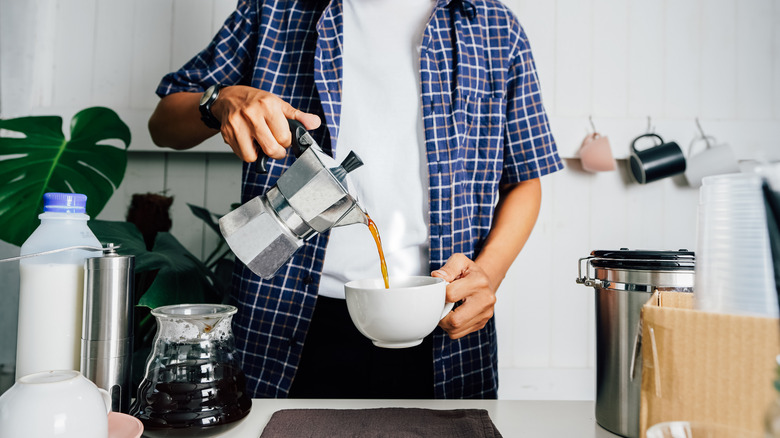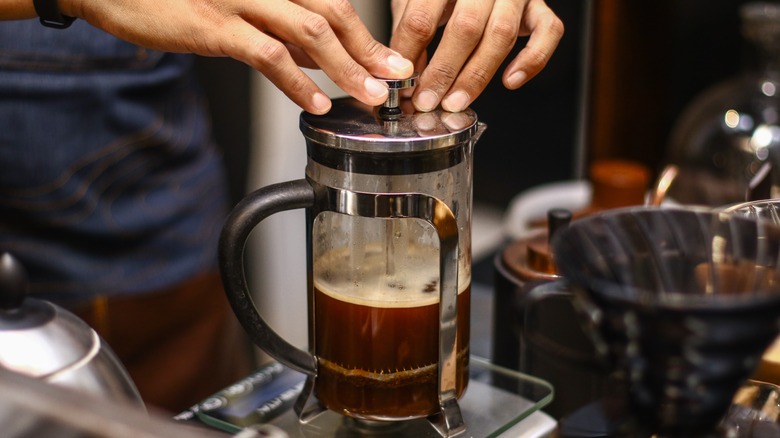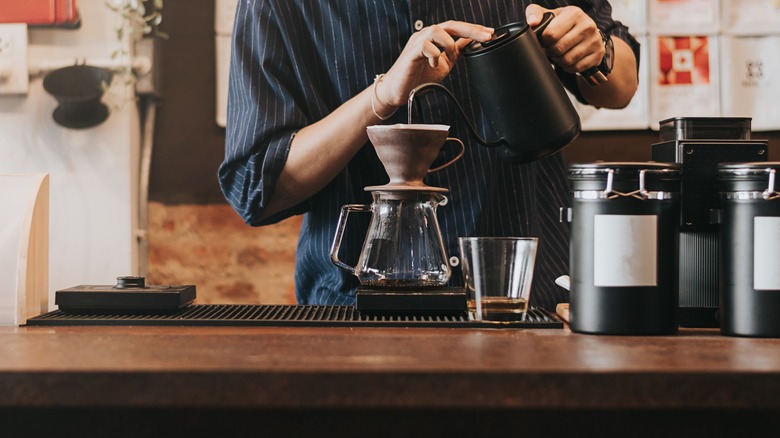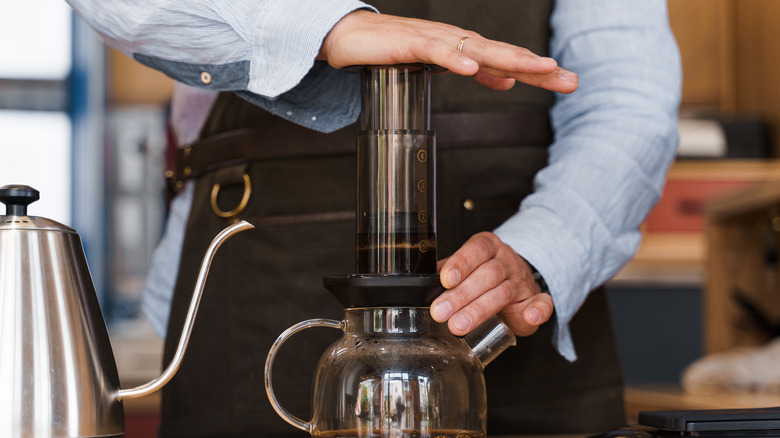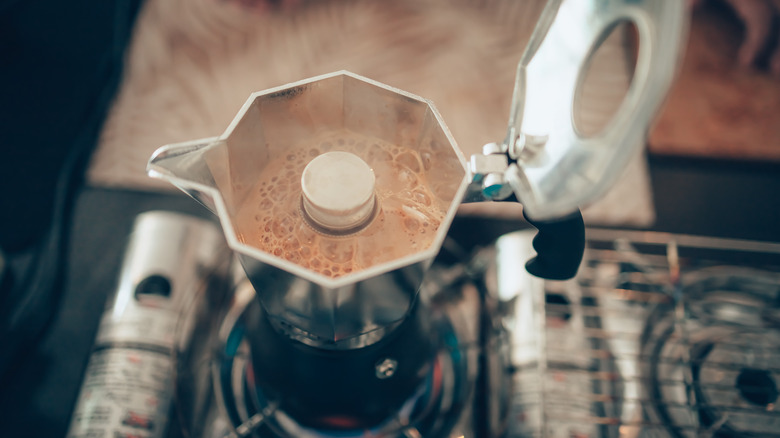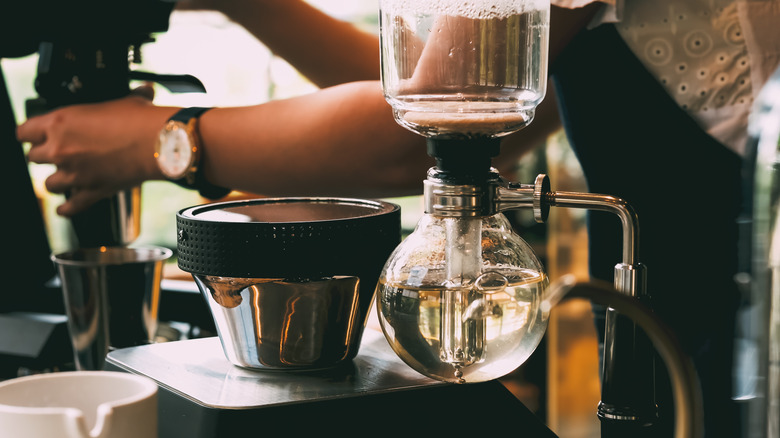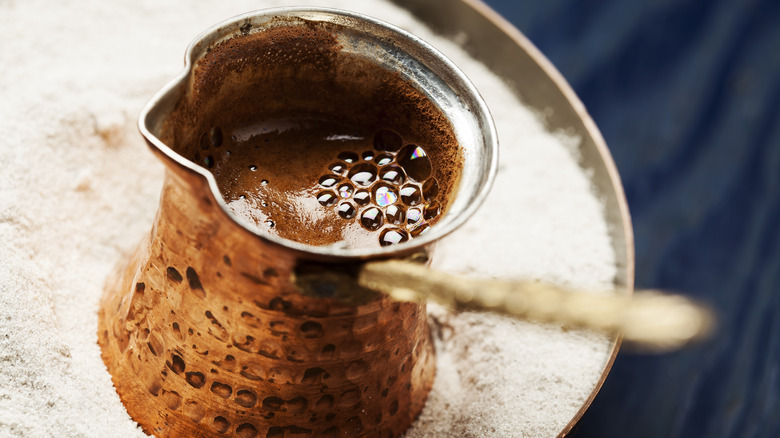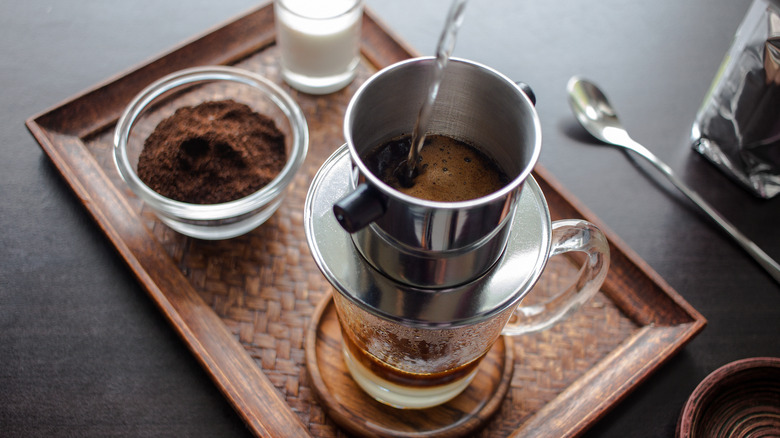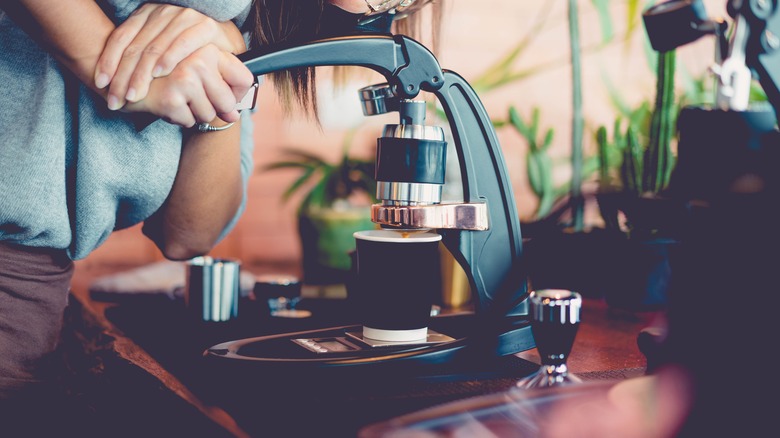8 Ways To Make Coffee Without A Coffee Maker
Coffee is an essential part of many people's daily routines. Coffee makers are convenient and can be a fairly affordable way to get a daily fix of coffee. But, sometimes, the coffee they make is lackluster, and the barista quality is missing. Those wanting to mix up their coffee recipes at home may be excited to hear that they can say "goodbye" to their traditional coffee maker without having to give up their morning brew.
To uncover all the ways to make coffee without a coffee maker, we spoke with Matthew Woodburn-Simmonds, a former barista and the specialist behind the Home Coffee Expert. Throughout our conversation, Woodburn-Simmonds shared some of his favorite java gadgets for making home-brewed coffee; from traditional Italian stovetop techniques to surprising new inventions, the ways to make coffee are endless. He says that more than one factor can contribute to why someone may want to consider an alternative coffee-making method.
"Alternative coffee-making methods can be a lot cheaper and provide a higher quality of coffee than plug-in coffee makers," said Woodburn-Simmonds. Along with quality and cost, he elaborated that countertop space and portability are other reasons why you might want to consider alternatives to traditional drip brewers. With that in mind, here are some other methods for making coffee without a typical coffee maker.
French press
French presses are an alternative to normal coffee makers that make a delicious and flavorful pot of coffee. The device contains a cylindrical beaker made of glass with a steel plunger and mesh strainer. Some prefer their morning brew in a French press. Matthew Woodburn-Simmonds said that this method is "one of the easiest methods to use and very cheap. Simply steep your coffee grounds for 4 minutes, plunge, and pour."
Any kind of medium-ground coffee will work in a French press, but medium and dark roasts will brew a rich and vibrant flavor with the help of a French press. The ideal water temperature is 195 to 200 F; this temperature should be achieved after letting a boiling kettle rest for a moment before pouring it into the French press. Stirring the hot water and grounds and letting it sit for a few minutes before pressing the plunger will enhance the flavors, as well.
French press coffee makers come in an abundance of volumes and price ranges. Most are made of glass and stainless with upgraded models utilizing double mesh filters, dishwasher-safe materials, or insulation. All of these factors are dependent on what the coffee drinker wants out of their French press and how frequently they use it.
Pour-over
Pour-over coffees are not just a creation of fancy coffee shops. Any coffee-lover can make one with a few extra moments to spare and a couple of different tools, though Matthew Woodburn-Simmonds does acknowledge its reputation. "One the coffee geeks love," he said, "and my personal favorite." Woodburn-Simmonds recommends using a cone and dripper contraption like a V60or Chemex to achieve a delicious cup of coffee.
Of the ways to make coffee, pour-overs are super simple and rely on the steeping process. A pour-over device has a chamber in which a filter and coffee grounds are placed as the entire pour-over contraption sits atop a mug or carafe. As hot water from a kettle is poured over the grounds, a brew slowly drips to make a full cup of coffee. Most baristas will recommend pouring multiple rounds of water over the coffee grounds to let them steep and bloom more than once. Special equipment like coffee grinders and swanneck kettles will help perfect the pour-over technique. Grinding coffee beans right before beginning the process will enhance the flavor, so a proper coffee grinder is a wise purchase. A swanneck kettle allows lots of control over pouring water, making it ideal for steeping delicate grounds.
"Pour-over makes very light-bodied, extremely aromatic coffee. It is best suited to lighter roasts and for trying out coffee from different regions of the world as the more nuanced flavors are easier to discern," said Woodburn-Simmonds.
AeroPress
The AeroPress was invented in 2005 by a Stanford University engineering lecturer. The gadget has multiple sections made of recyclable plastic that work together to craft a cup of coffee; the chamber with a filter and seal sits atop the coffee cup. A plunger is used to push air through the grounds after they've been steeped in water.
"AeroPress makes coffee somewhere between French press and pour-over, depending on the exact brewing method," Matthew Woodburn-Simmonds told us. "Steeping the grounds in the chamber adds body to the coffee, but it is still filtered through a paper filter, so you get a clean mouthfeel with fewer oils." This device is portable, simple, and makes a mean cup of coffee.
Using the AeroPress may seem intimidating at first, but practice makes perfect. After combining water and grounds in the brewing chamber, the plunger traps air pressure, which is forced down onto the mixture, brewing coffee into your cup through a filter. Medium-ground coffee is compatible with an AeroPress; larger grounds may cause a faster drip, and fine grounds will create more resistance. Light roast Arabica coffee tastes best in an AeroPress.
The original AeroPress costs around $40, and the manufacturer offers other models for aesthetic and size needs. The original and travel-sized models are ideal for coffee lovers on the go; campers, commuters, or even people needing a caffeine boost from their desk can rest assured that these devices will deliver a great cup of coffee and are durable for travel.
Moka pot
Moka pots are an iconic Italian coffee maker made of steel or aluminum that an electric or gas stove heats to brew the coffee. Its inventor began experimenting in 1918 with ways to bring espresso from coffee houses into the home, accomplishing his goal in 1933 when it hit markets. Many people love the simplicity of the Moka pot and the espresso-like flavor. "Moka pot makes bold, intense, and slightly bitter coffee due to boiling the water and the slight pressure used to extract the flavors," said Matthew Woodburn-Simmonds
It nests on the stovetop, creating vapor pressure that brews the coffee grounds through different chambers. The original technology is still what most aluminum Moka pots use today. Moka pots are adored for their simplicity. After pouring water into the bottom chamber and coffee grounds into the, it heats up on the stove for a few minutes before it's ready to drink. Coffee grounds should be medium-fine for Moka pot use, and any kind of coffee bean can work just fine in a Moka pot.
Moka pots can travel anywhere with a stove and should be rinsed with water after each use; washing them with vinegar and lemon every so often will break down any coffee build-up. Moka pots come in many different sizes based on how many cups they make at a time. Whatever size of Moka pot, it's important to note that they work best when the full amount of water and coffee are used.
Siphon
Siphoning turns a simple cup of Joe into a full-blown chemistry experiment in the best way possible. The device is often made of glass and has two different chambers that create pressurized vapor, which brews the coffee. The difference in densities draws the water into the top chamber until the heat source is turned off. Pressure falls, and the brewed coffee fills the bottom chamber again. "Siphon can make very light-bodied and aromatic coffee, but it's difficult to get right," according to Matthew Woodburn-Simmonds.
Using a siphon is scientific, and the process will take a few brews to get used to. First, add water to the lower chamber and turn on the heat source (either a gas burner or what comes with the siphon when purchased). Coffee grounds are whisked in the chamber. The pressure will separate the brewed coffee and grounds into their respective chambers, readying the coffee for serving. Per our expert, making a quality cup relies on other factors, too. "It depends on the filter," said Woodburn-Simmonds. "A cloth filter will leave a texture similar to the French press, but with a lighter body."
Coffee siphons cost about $40 to $150 on average, but high-end options can market at $400 or more. Baristas recommend using water from a purifier and freshly roasted, high-quality coffee grounds for the best results. Coffee siphons need a good deal of cleaning, and it's a good practice to run water through them after each use, with monthly scrubs with dish soap.
Ibrik (Turkish coffee)
An ibrik is essential to making a gorgeous cup of Turkish coffee. The device has a long handle connected to a copper pot with a large bottom that narrows toward the opening. The pot boils on a stovetop, creating a rich, bitter coffee flavor. Sugar and finely ground coffee are often the key to success in an ibrik coffee recipe. Matthew Woodburn-Simmonds explains it as such: "Ibrik produces rich, intense, bitter coffee that really needs sugar to shine. The boiling of the coffee produces bitter notes, which are countered by adding sugar. The foam that is spooned on top adds a pleasant extra texture."
Making Turkish coffee successfully starts with a very finely ground coffee. The water, coffee grounds, and optional sugar will all boil together without being filtered, so it's essential to use powder-like coffee grounds so none ends up in the bottom of the cup. Coffee experts recommend using Arabica coffee beans to enhance the nutty, aromatic, and traditional flavors of Turkish coffee.
Dressing up the coffee is necessary if the drinker doesn't want an overly bitter result. Adding in sugar will counter the intensity of the coffee flavor that the Ibrik produces. Some people use extra ingredients to upgrade the coffee; spices such as cinnamon or cardamon are commonly employed to enhance the flavor.
Phin
Phin filters are a popular Vietnamese brewing method. "The slow drip of phin coffee gives a very intense and bitter brew. Especially when using the traditional Robusta beans of Vietnam," per Matthew Woodburn-Simmonds. It is customary to stir in sweeteners after the coffee has been completely brewed. According to Woodburn-Simmonds, phin coffee is "ideal with a spoon of sugar or some condensed milk for that true Vietnamese coffee experience." Phin filters create a more acidic coffee taste than other methods, so some drinkers may prefer to cut that flavor with something saccharine.
The phin filter is typically made of aluminum or stainless steel and contains a cap, a press, a brewing chamber, and a filter that sits beneath the chamber. After pouring hot water from a kettle into the filter, the gravity press pushes coffee grounds through the water. It takes 2 to 5 minutes for the coffee to drip from the strainer to the mug. Phin coffee is often served in a glass cup, and you should be careful with the drinking vessel you choose: mug color can affect a coffee's taste.
Stainless steel Phin filters will keep the brewing coffee warmer than aluminum ones, which tend to cool down quicker. Since the whole device sits on top of a coffee cup, it is perfect for travel and easy to clean. These brewers cost anywhere from $10 to higher-end options priced at $70. Many phin fans like that they eliminate waste because the devices require no disposable filters.
Manual espresso maker
Most coffee lovers are familiar with the work of semi-automatic or automatic espresso machines, which brew with a few adjustments at the press of a button. However, some will want full control over their espresso and may desire the quality — and challenge — of a manual espresso press. "If you really, really want to get into the espresso-making weeds, then you can get a manual espresso maker," said Matthew Woodburn-Simmonds. As far as replacing your traditional coffee maker, however, he noted that there are a lot more variables should you choose this machine.
"You have to control every single element of pulling shots," he said. "[It] requires money, time, effort, patience, and skill, but results can be spectacular." Manual espresso machines operate through a lever system that builds pressure, resulting in a shot of espresso and enough pressure to create the signature espresso crema. Manual espresso machines are hard to perfect and typically cost $500 to $1,000, making this the method for the most dedicated espresso fans.
There are a few different types of manual espresso machines. Spring pistons contain a spring in the head of the machine that releases after the lever is pulled, forcing hot water to push through the coffee grounds to create the espresso shot. Direct-lever manual espresso machines rely on levers to pressure the water through the coffee grounds. The spring piston machines are easier to use, but the direct lever machines allow the barista full control over how the espresso is made.
